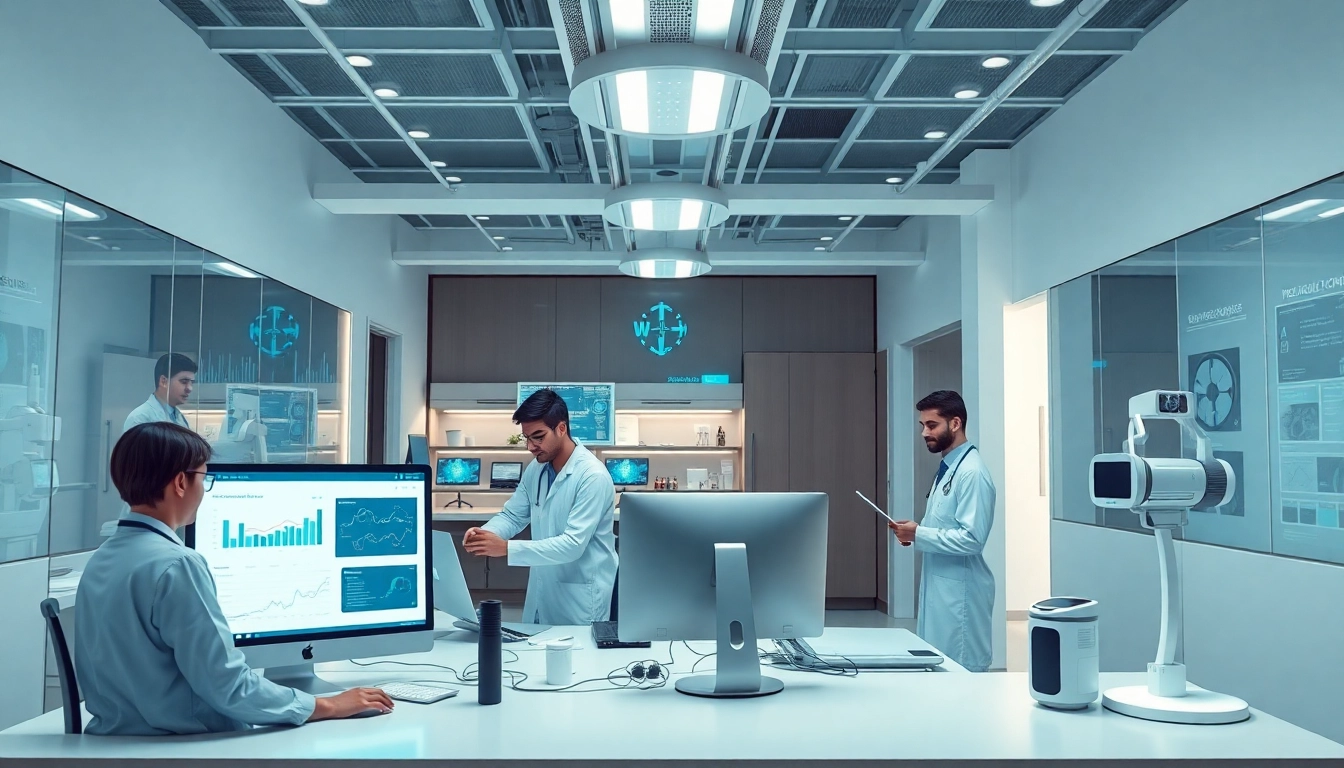Understanding Informatics in Healthcare
Informatics in healthcare refers to the integration of information technology (IT) with healthcare processes, focusing on improving patient care through efficient data management and communication. The effective deployment and utilization of informatics not only streamline healthcare operations but also result in better clinical outcomes. A key aspect of this field is the use of the internet and software applications that enhance the accuracy and accessibility of patient information, which is vital for effective decision-making in medical contexts. For more insights on informatics applications in healthcare, you can visit https://www.informaticsview.com.
Definition and Scope of Healthcare Informatics
Healthcare informatics is a multidisciplinary field that combines elements of computer science, information science, and healthcare to manage health data and improve patient care. It encompasses a variety of practices and technologies, including electronic health records (EHR), interoperability systems, health information exchanges (HIE), and telemedicine. The primary goal of healthcare informatics is to enhance the efficiency and quality of care delivered to patients while maintaining the privacy and security of their information.
The scope of healthcare informatics extends to various functions, including:
- Data Management: Handling and analyzing large volumes of health data to derive actionable insights.
- Clinical Decision Support: Providing healthcare professionals with intelligent tools that help them make informed decisions based on real-time data.
- Patient Engagement: Utilizing technology to foster greater communication between patients and healthcare providers.
- Research: Facilitating data sharing for research purposes, thereby advancing medical knowledge and practice.
Key Components of Informatics Systems
A robust informatics system comprises multiple key components that work in tandem to ensure efficient health data management. These components include but are not limited to:
- Electronic Health Records (EHR): A digital version of a patient’s paper chart that contains the medical history, diagnoses, medications, treatment plans, immunization dates, allergies, radiology images, and laboratory results. It is integral to improving the coordination of care among different providers and enhancing communication.
- Health Information Exchanges (HIE): Networks that enable the electronic sharing of health-related information among different organizations, ensuring that pertinent patient data is available at the point of care, where timely information can significantly influence outcomes.
- Clinical Decision Support Systems (CDSS): Tools that analyze data within patient records and provide healthcare professionals with recommendations or alerts that improve decision-making regarding patient care.
- Telemedicine Platforms: Technologies that facilitate remote healthcare services, which have gained prominence, especially during the COVID-19 pandemic, enabling consultations without the need for in-person visits.
Importance of Informatics in Modern Healthcare
Informatics plays a crucial role in transforming healthcare delivery by fostering data-driven decision-making and improving overall patient safety. Its importance is underscored by several key benefits:
- Improved Patient Outcomes: Studies have shown that effective use of informatics systems correlates with reduced clinical errors and improved patient outcomes by providing timely and accurate information at the point of care.
- Increased Efficiency: By streamlining processes and reducing redundancies, informatics helps healthcare organizations operate more efficiently, saving time and resources.
- Enhanced Research Capabilities: Access to comprehensive health data allows researchers to study patterns, develop new treatments, and improve existing healthcare protocols.
- Patient Empowerment: Patient portals and mobile health applications empower individuals to take charge of their health by providing easy access to their health information and enhancing communication with providers.
Challenges in Implementing Informatics Solutions
Despite the promise of informatics in enhancing healthcare delivery, several challenges can arise during the implementation of these solutions. Acknowledging and addressing these challenges is critical for successful deployment.
Common Roadblocks in Healthcare Informatics
Common roadblocks to implementing informatics solutions can include the following:
- Resource Limitations: Many healthcare facilities, particularly smaller organizations or rural hospitals, may lack the financial or technical resources necessary for comprehensive informatics implementations.
- Staff Resistance: Employees may resist adopting new technologies, fearing change or facing challenges in learning to use new systems.
- Interoperability Issues: The inability of disparate systems to effectively communicate with each other can hinder the flow of information, making it difficult to access comprehensive patient records.
- Insufficient Training: Without proper training programs for staff, even the best informatics solutions can underperform due to users’ lack of knowledge on how to utilize them effectively.
Data Security and Privacy Considerations
The healthcare sector is particularly vulnerable to data breaches, which can have dire consequences for patients and organizations alike. As such, ensuring data security and compliance with regulations like HIPAA (Health Insurance Portability and Accountability Act) is vital when implementing informatics solutions. Healthcare organizations must prioritize the following:
- Encryption: Utilizing data encryption protocols to protect sensitive health information from unauthorized access.
- Access Controls: Implementing stringent access controls to ensure that only authorized personnel can view or edit patient information.
- Regular Audits: Conducting audits to identify vulnerabilities and ensure compliance with data protection laws.
- Staff Training: Training employees on data security best practices to minimize the risk of human error, which is often the weakest link in security.
Overcoming Resistance to Change
Overcoming resistance to change is crucial for successful implementation. Strategies may include:
- Involving Stakeholders: Engage healthcare workforce in the decision-making process to foster a sense of ownership and collaboration.
- Demonstrating Benefits: Clearly communicate how informatics solutions enhance their workflow, patient outcomes, and reduce administrative burdens.
- Tailored Training Programs: Implement training that resonates with users, addressing their unique needs and potential obstacles, demonstrating real-world applications of the new systems.
Best Practices for Successful Implementation
To facilitate the successful implementation of healthcare informatics, organizations can apply several best practices that promote a seamless transition to digital workflows and data use.
Engaging Stakeholders in the Process
Engaging various stakeholders — including clinical staff, IT departments, and administrative personnel — is essential for successful informatics deployment. Strategies for engagement include:
- Creating Collaborative Committees: Form committees composed of representatives from each department to share feedback and concerns, fostering a collaborative environment.
- Regular Updates and Feedback Loops: Keep stakeholders informed about progress and solicit their feedback to continuously improve the process.
- Celebrating Milestones: Recognize achievements and milestones during the implementation process to maintain morale and encourage continued participation.
Measuring Impact and Outcomes
Once informatics solutions have been implemented, it is crucial to monitor their impact. Organizations should establish metrics to measure key performance indicators such as:
- Patient Satisfaction: Survey patients to assess their experiences with the new systems, which can provide insights into perceived improvements in care.
- Clinical Outcomes: Analyze patient outcomes data to determine whether the informatics systems improve treatment effectiveness and reduce errors.
- Operational Efficiency: Measure reduced wait times, increases in patient throughput, or other operational metrics that indicate enhanced efficiency.
Training and Supporting Users
Comprehensive training and ongoing support are vital components of successful informatics implementation. Organizations should consider:
- Structured Onboarding Programs: Develop structured onboarding programs that include both theoretical and practical training tailored to diverse professional roles.
- Continuous Learning Opportunities: Offer opportunities for continuous education on new features or updates to the system.
- Responsive Support Services: Ensure that users have access to readily available support for troubleshooting and assistance, creating a safety net for those who may struggle with new technologies.
Case Studies: Successful Informatics Implementations
Real-world examples demonstrate how healthcare informatics can lead to significant improvements in patient care, operational efficiencies, and data management practices. The following case studies highlight successes across various healthcare settings.
Hospital A: Improving Patient Outcomes with EHRs
Hospital A, a mid-sized facility, implemented an advanced EHR system to streamline patient records, improve clinical workflows, and enhance communication among staff. By digitizing records, the hospital saw a 25% reduction in medical errors and a 15% improvement in patient satisfaction scores within the first year. Key components of their implementation included extensive staff training, engagement in the selection process, and establishing a robust feedback loop to optimize the system post-implementation.
Clinic B: Streamlining Operations with Telemedicine
Clinic B transitioned to incorporate telemedicine solutions, providing remote consultations for patients, which became vital during the COVID-19 pandemic. This shift led to an increase in patient volume by 30% and improved access to care for patients in rural areas. By investing in a user-friendly telehealth platform and ensuring adequate training for staff, the clinic significantly enhanced their operational efficiency.
Health System C: Enhancing Data Sharing and Collaboration
Health System C established a centralized health information exchange that allowed for seamless data sharing between various departments and external providers. This initiative improved care coordination, as evidenced by a 20% reduction in hospital readmission rates. By engaging stakeholders throughout the process and proactively addressing data security concerns, the system made strides toward becoming a model for collaborative care.
The Future of Healthcare Informatics
The landscape of healthcare informatics is continually evolving, driven by advancements in technology, changes in regulation, and shifts in patient expectations. Looking to the future, healthcare organizations must remain adaptable and forward-thinking.
Trends Shaping the Informatics Landscape
Several trends are emerging that will shape the future of healthcare informatics, including:
- Artificial Intelligence (AI): AI is revolutionizing data analysis, enabling predictive analytics for patient outcomes, and automating routine tasks.
- Interoperability: As demands for data sharing increase, systems that promote interoperability will become essential for coordinating care across platforms.
- Patient-Centered Care: A strong focus on the patient experience will lead to greater demand for user-friendly interfaces and solutions that empower individuals to engage with their health.
Innovations on the Horizon
Innovations such as wearable health devices, blockchain technology for secure patient data sharing, and advanced telehealth options are on the horizon. These technologies promise to further enhance patient monitoring and engagement while ensuring data integrity and privacy.
Preparing for the Next Wave of Informatics
To prepare for the next wave of healthcare informatics advancements, organizations must prioritize:
- Agile IT Infrastructure: Investing in adaptable and scalable IT infrastructure that can accommodate new technologies and evolving needs.
- Continuous Training: Emphasizing lifelong learning and professional development to keep staff informed and adept with emerging technologies.
- Collaboration and Partnerships: Collaborating with technology vendors, academic institutions, and other organizations to leverage collective expertise and resources.



